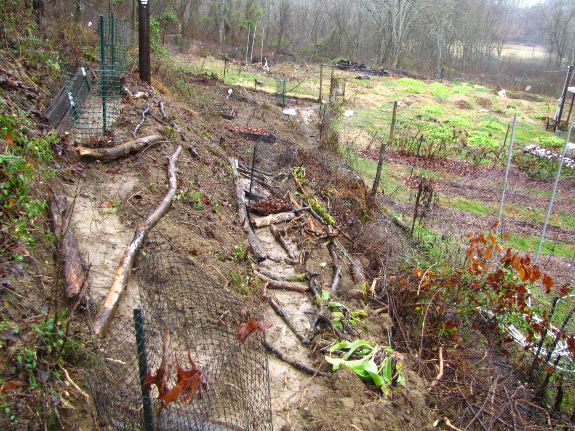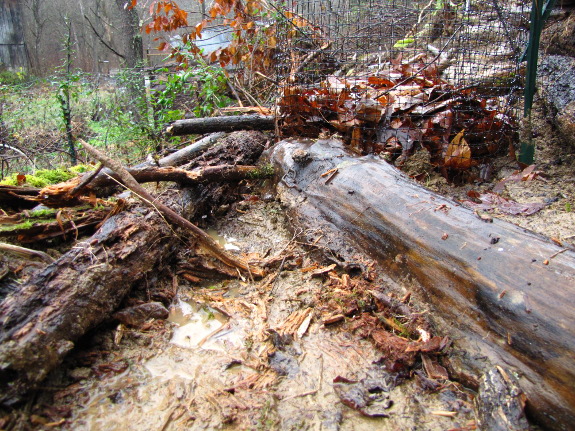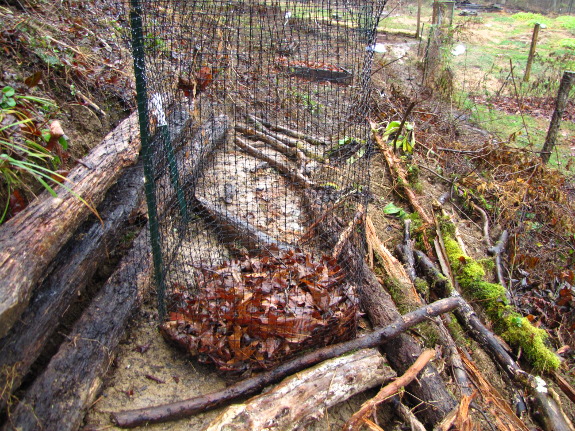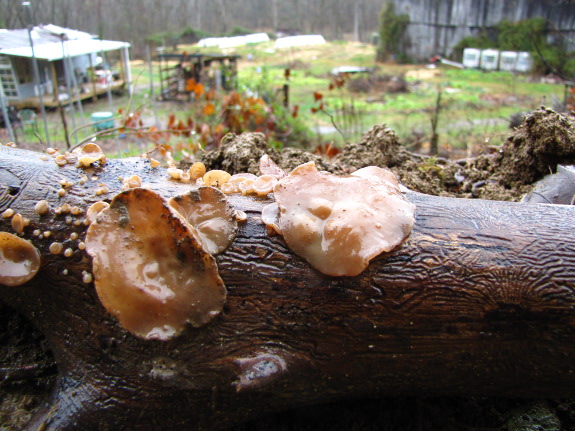
Holding water on a slope with punky wood

Part of the reason I
thought it was worthwhile to put a lot of effort into terracing
the powerline pasture
is completely unrelated to chickens and instead has to do with
water. The forest garden turns into a swamp during wet weather,
and while I've blamed the excess water on everything from barn roof
overflow to compacted clay soil, I'm willing to entertain the notion
that the powerline cut has something to do with it as well. After
all, wet weather springs pop up at the base of that hillside during
winter rains, suggesting that the lack of vegetation resulting from
cutting trees along the powerline has sped up flow of water, resulting
in a glut down below.

In her new ebook, One
Acre Homestead, Sara
McDonald writes about slowing the flow of energy through a system: "The
flow must be maintained, but catching and storing energy for beneficial
purposes is encouraged." In other words, one solution to my
problem would be to keep water on the hillside longer, where it can
hydrate plants and be transpired out through their leaves rather than
flooding the forest garden below. Many permaculture practitioners
use ponds to slow the flow of water, but I want to keep things simpler
by soaking up excess water with humus.

A trip into the nearby
woods turned up plenty of punky sticks and logs already rotting into
the ground. I used the drop test to determine which ones were
ready to move to the powerline cut --- if the wood broke into small
enough pieces to haul when thumped on the ground, I figured it was
ready. Six trips later, the terraces were looking a little less
barren and I was worn out.

I'll probably add more
wood later, since this is just the bare minimum needed to hold
unvegetated soil in place, but even this little bit should help.
In the immediate future, the logs will force water to pool behind them
during heavy rains, tempting more liquid to soak into the earth rather
than running off, and soon the wood will have rotted enough to suck up
rain and release it slowly during droughts. The wild fungi that
came along for the ride can't hurt either.
Want more in-depth information? Browse through our books.
Or explore more posts by date or by subject.
About us: Anna Hess and Mark Hamilton spent over a decade living self-sufficiently in the mountains of Virginia before moving north to start over from scratch in the foothills of Ohio. They've experimented with permaculture, no-till gardening, trailersteading, home-based microbusinesses and much more, writing about their adventures in both blogs and books.
Want to be notified when new comments are posted on this page? Click on the RSS button after you add a comment to subscribe to the comment feed, or simply check the box beside "email replies to me" while writing your comment.

Thanks for the mention. What a cool project! I can't wait to see your terrace garden in a few years.
I was working on a stream bank restoration project last year where we planned to use a sterile Vetiver ('Sunshine' variety) plant to hold the soil back, similar to the way you plan to use Comfrey. Vetiver has an amazing root structure so it's ideal for this kind of work. I thought I'd mention it for anyone who is in a near tropical climate and considering a similar type of project.
Sara --- Thanks for the suggestion! I'll bet it'll be helpful for warm-weather gardeners.
Daddy --- I couldn't seem to get alfalfa to take hold in poor soil areas. Have you tried it outside of good agricultural soil?